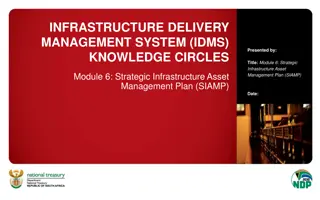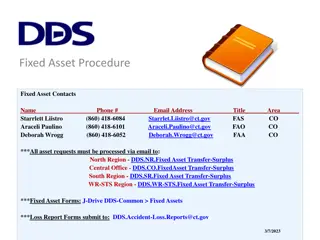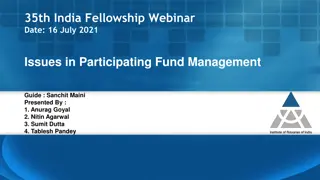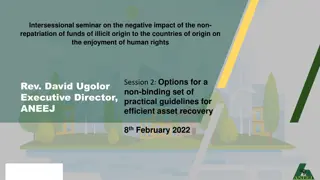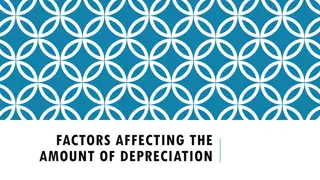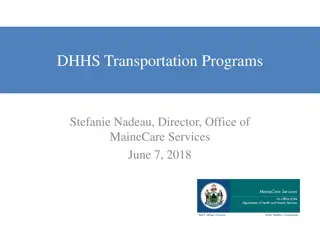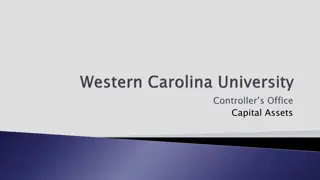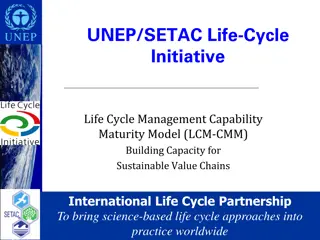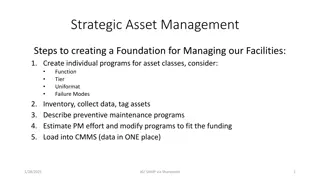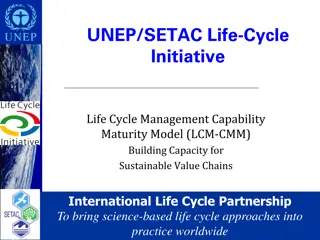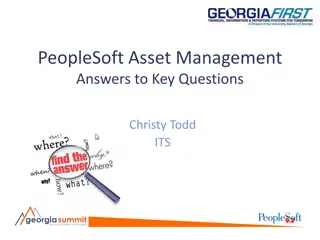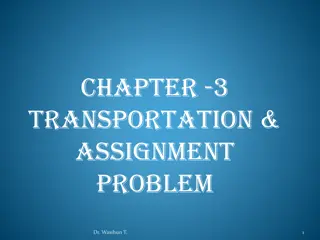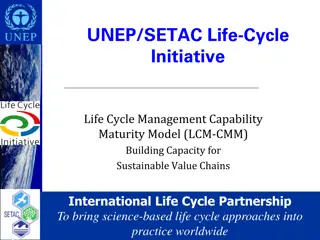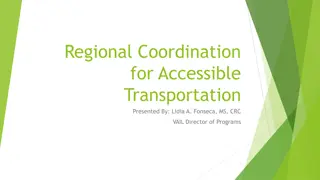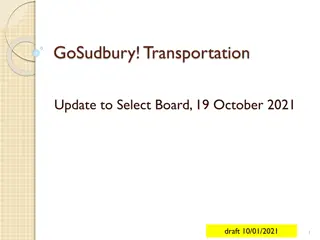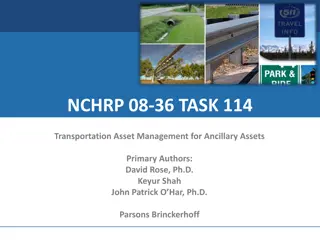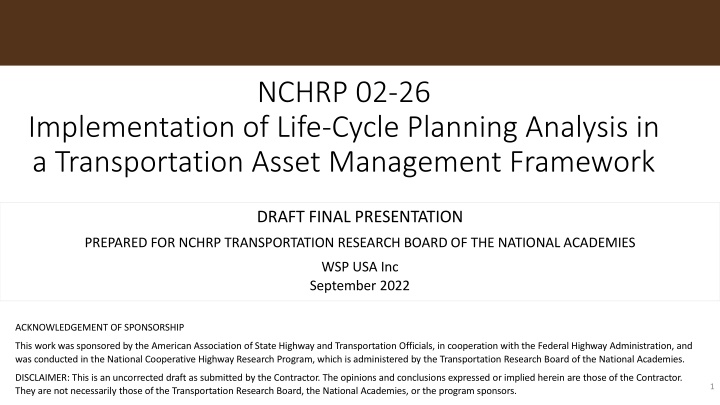
Implementation of Life-Cycle Planning in Transportation Asset Management
This draft final presentation explores the implementation of life-cycle planning analysis within a transportation asset management framework. Sponsored by AASHTO and FHWA, the study was conducted as part of NCHRP and administered by TRB.
Uploaded on | 0 Views
Download Presentation

Please find below an Image/Link to download the presentation.
The content on the website is provided AS IS for your information and personal use only. It may not be sold, licensed, or shared on other websites without obtaining consent from the author. If you encounter any issues during the download, it is possible that the publisher has removed the file from their server.
You are allowed to download the files provided on this website for personal or commercial use, subject to the condition that they are used lawfully. All files are the property of their respective owners.
The content on the website is provided AS IS for your information and personal use only. It may not be sold, licensed, or shared on other websites without obtaining consent from the author.
E N D
Presentation Transcript
NCHRP 02-26 Implementation of Life-Cycle Planning Analysis in a Transportation Asset Management Framework DRAFT FINAL PRESENTATION PREPARED FOR NCHRP TRANSPORTATION RESEARCH BOARD OF THE NATIONAL ACADEMIES WSP USA Inc September 2022 ACKNOWLEDGEMENT OF SPONSORSHIP This work was sponsored by the American Association of State Highway and Transportation Officials, in cooperation with the Federal Highway Administration, and was conducted in the National Cooperative Highway Research Program, which is administered by the Transportation Research Board of the National Academies. DISCLAIMER: This is an uncorrected draft as submitted by the Contractor. The opinions and conclusions expressed or implied herein are those of the Contractor. They are not necessarily those of the Transportation Research Board, the National Academies, or the program sponsors. 1
NCHRP 02-26 Life Cycle Planning Implementing LCP LCP Framework Introduction to LCP LCP Enablers Conducting LCP Life-Cycle Planning Definitions Life-Cycle planning means a process to estimate the cost of managing an asset class, or asset sub-group over its whole life with consideration for minimizing cost while preserving or improving the condition Life-cycle planning lays out the processes and procedures for the life cycle management of every asset class Lifecycle planning is about optimization of costs, service goals, and risks (including extreme weather & resilience) over the life-cycle of an asset. Title 23 CFR 515.5 Definitions 2
NCHRP 02-26 Life Cycle Planning Implementing LCP LCP Framework Introduction to LCP LCP Enablers Conducting LCP LCP Objectives With or without performance constraints Identify an optimum preservation strategy to minimize life cycle costs under a given investment scenario Asset Level Unconstrained optimization Determine the level of investments required to achieve performance objectives Network Level Unconstrained optimization Identify long term investment needs (beyond financial planning period) Budget-constrained and performance-constrained optimization. Determine the level of performance that can be achieved under a given investment scenario
NCHRP 02-26 Life Cycle Planning Implementing LCP LCP Framework Introduction to LCP LCP Enablers Conducting LCP Life-Cycle Planning in the Transportation Asset Management (TAM) context System Level Maximize the value of investments (cross-asset or cross-modal) made in achieving system objectives Program Level Asset Level Selecting the Right Treatment at the Right Time to minimize life-cycle costs Selecting the Right Project for the Program (of same asset classes) to maximize network performance
NCHRP 02-26 Life Cycle Planning Implementing LCP LCP Framework Introduction to LCP LCP Enablers Conducting LCP Practice of Life Cycle Planning Role of LCP in TAM and its benefits are well understood Variance in TAM practices among STAs and across asset classes Effectiveness of LCP influenced by risks and uncertainties Need a framework that builds on existing practice, adaptable to DOT practices, and serves all asset classes Need a framework to incorporate risks and uncertainties LCP is being practiced in some form by most state transportation agencies (STAs) Computational power needed for optimization in LCP analysis is a challenge Need solutions to reduce computational bottlenecks Effectiveness of LCP influenced by maturity of LCP enablers Need a benchmark for DOTs to advance maturity through continual improvement
NCHRP 02-26 Life Cycle Planning Implementing LCP LCP Framework Introduction to LCP LCP Enablers Conducting LCP Life-cycle Planning High-Level Steps Set up LCP for both asset and network level analyses 1 Establish intervention thresholds at the asset level 2 Plan and select treatments at the asset level 3 Develop work program, determine performance gaps & provide input to financial plan 4
NCHRP 02-26 Life Cycle Planning Implementing LCP LCP Framework Introduction to LCP LCP Enablers Conducting LCP Generalized Life-Cycle Activity Plan For a combination of treatment type, timing & service life estimates
NCHRP 02-26 Life Cycle Planning Implementing LCP LCP Framework Introduction to LCP LCP Enablers Conducting LCP Life Cycle Planning Enablers Performance Measures Deterioration Models Asset Identifiers Treatment Strategies and Effectiveness Economic Analysis Policies Technology and Information Systems Work Supplementary Data Programming Will be covered in more detail in this presentation
NCHRP 02-26 Life Cycle Planning Implementing LCP LCP Framework Introduction to LCP LCP Enablers Conducting LCP Performance Measures System Preservation, Mobility, Safety, Reliability, and Economics Asset Functional Condition Ability to serve the user: ride, safety, operations, and other functional purposes Asset Structural Integrity Ability to withstand loads (environmental, traffic or electrical) Economic Life cycle Costs Obsolescence Functional Obsolescence Requires expansion (e.g., bridge widening) Technological Obsolescence - Requires modernization Economic Obsolescence Requires replacement Legal Obsolescence Requires upgrade to new standards Risk of Asset Failure Structural Reliability Indicates the ability of the asset not to fail or malfunction under normal operating conditions Frequency-based e.g., survival analysis Condition-based e.g., time to reach a specific threshold (RSI) Design-based e.g., bridge reliability index ( ) Vulnerability Risk of Service Disruption Mobility, Safety, Freight Movement and Economic Vitality Measures and/or User costs
NCHRP 02-26 Life Cycle Planning Implementing LCP LCP Framework Introduction to LCP LCP Enablers Conducting LCP Performance Measures End of Life Considerations Engineering (Condition-based) Gradual loss in function Sudden or physical failure Modernization Safety Operational Obsolescence (raised standards) Reliability Economic/Life cycle cost-based When Net Present Value (replacement) is the most cost-effective option Bridges - Typical End of Life Gradual loss in function, as indicated Rock falls are stochastic. High intensity events exceeding the capacity of Rockfall Scenario - Typical End of Life Pavements - Typical End of Life Gradual loss in function as structural cracking exceeds the acceptable limits by NBI/NBE condition states, and risk of sudden failure protection systems cause failure 9.0 1 100 8.0 High Energy Rockfall Event (stochastic) Exceeding Capacity Excellent 90 7.0 80 Low Energy Rockfall 2 70 Event (stochastic) 6.0 Condition Rating Condition State NBI Rating 60 5.0 50 3 4.0 40 Temporary Repairs 3.0 30 Deck Superstructure 4 2.0 20 Threshold Poor Substructure Service Disruption NBI Threshold 1.0 10 0 0.0 5 0 5 5 10 15 20 25 30 35 40 25 Failed 0 5 10 15 20 25 30 35 40 45 50 55 60 65 70 75 10 15 0 20 Pavement Age Structure Age Time in years High Energy Rockfall Scenario Low Energy Rockfall Scenario
NCHRP 02-26 Life Cycle Planning Implementing LCP LCP Framework Introduction to LCP LCP Enablers Conducting LCP Performance Measures Establishing Condition Thresholds Generally set by engineering, policy and regulatory requirements Cost-effectiveness approach Intervention Timing & Thresholds: Hastened vs Deferred Assessment of agency costs, user costs, and effectiveness Monetized approach (e.g. EAC) Performance Area approach 120% Window of Opportunity CER at a given intervention year to CER at 100% Optimal Intervention 80% 60% Hastened Deferred 40% 20% 0% -4 -2 0 2 4 Intervention Year: Deviation from Optimal Timing, years Condition Measure: Deviation from Established Threshold
NCHRP 02-26 Life Cycle Planning Implementing LCP LCP Framework Introduction to LCP LCP Enablers Conducting LCP Deterioration & Survival Models Pessimistic (Hazard) Scenario Deterioration Rates Deterioration Models Age-based regression models Markov transition matrices Survival Models Non-parametric (Kaplan Meier) Semi-parametric (Cox proportional hazards) Parametric (Weibull, log normal) Typical Scenario Survival Curve Optimistic Scenario
NCHRP 02-26 Life Cycle Planning Implementing LCP LCP Framework Introduction to LCP LCP Enablers Conducting LCP Asset Deterioration Models Pavement Deterioration Models Composite Index of Individual Distresses Forecast time to or time at which an asset reaches a condition state Indicate deterioration & failure modes Model probabilities in forecasting Incorporate causality 100.0 90.0 80.0 Distress Index Value 70.0 60.0 50.0 40.0 30.0 20.0 10.0 0.0 0 10 20 30 40 50 Pavement age (years) Longitudinal Cracking Alligator Cracking Rutting
NCHRP 02-26 Life Cycle Planning Implementing LCP LCP Framework Introduction to LCP LCP Enablers Conducting LCP Asset Deterioration Models Bridge Models Transition Matrix of Condition States Forecast time to or time at which an asset reaches a condition state Indicate deterioration & failure modes Model probabilities in forecasting Incorporate causality
NCHRP 02-26 Life Cycle Planning Implementing LCP LCP Framework Introduction to LCP LCP Enablers Conducting LCP Asset Deterioration Models TSMO Bath-Tub Conceptual Model Forecast time to or time at which an asset reaches a condition state Indicate deterioration & failure modes Model probabilities in forecasting Incorporate causality
NCHRP 02-26 Life Cycle Planning Implementing LCP LCP Framework Introduction to LCP LCP Enablers Conducting LCP Treatment Planning and Selection Treatment planning and selection at the asset level 3
NCHRP 02-26 Life Cycle Planning Implementing LCP LCP Framework Introduction to LCP LCP Enablers Conducting LCP Treatment Planning Selection of Feasible Treatment Categories Developing Life Cycle Activity Plans Incorporate Risks in Treatment Planning Selection of Preferred Treatment Category Do Nothing Preservation Rehabilitation Reconstruction Optimal treatment sequence Possible combinations Reduction techniques Reliability considerations Treatment costs LCCA NPV Annualized Costs Benefits Area Under the Curve Monetized Ranking by IBC Pareto s Efficiency Frontier
NCHRP 02-26 Life Cycle Planning Implementing LCP LCP Framework Introduction to LCP LCP Enablers Conducting LCP Time to Intervention Bridge Example Rating 9 8 7 6 5 4 3 2 1 Condition Excellent Very good Good Satisfactory Fair Poor Serious Critical Imminent failure Failed Indicator Good Good Good Fair Fair Poor Poor Poor Poor Preservation Rehabilitation Reconstruction Remaining Life to CR 5.5 (P, RH) 13.6 12.9 12.2 11.5 10.9 10.2 9.5 8.7 6.5 (P) 4.4 3.7 3.0 2.3 1.6 0.9 0.2 0.0 4 3 X X X X Age (t) 15 16 17 18 19 20 21 22 CR 7.0 6.9 6.8 6.8 6.7 6.6 6.5 6.4 (RH, RC) 29.1 28.4 27.7 27.0 26.3 25.6 24.9 24.2 (RC) 40.9 40.2 39.5 38.8 38.1 37.4 36.7 36.0 X X X X X X 0 Poor X Treatment Recommendations by General Condition Ratings Time to Intervention Calculations
NCHRP 02-26 Life Cycle Planning Implementing LCP LCP Framework Introduction to LCP LCP Enablers Conducting LCP General Asset Management Problem Interval 1 DN DN DN DN P P P P RC RC RC RC Interval 2 DN DN DN DN Interval 3 DN DN DN DN Interval 4 DN DN DN DN Interval 5 DN DN DN DN Interval 6 DN DN DN DN Interval 7 DN DN DN DN Interval 8 DN DN DN DN Interval 9 DN DN DN DN Interval 10 DN P RH RC DN Start DN DN DN . . . .. P P P P . . . .. High computational resources DN DN DN DN DN DN DN DN DN DN DN DN DN DN DN DN DN DN DN DN DN DN DN DN DN DN DN DN DN P RH RC DN DN DN DN RH RH RH RH . . . .. DN DN DN DN DN DN DN DN DN RC RC RC RC . . . .. RC RC RC RC RC RC RC RC RC Interval 1 (4) Interval 2 (16) Interval3 (64) Interval 10 (1048576) DN RC DN RC DN RC DN RC DN RC DN RC DN RC DN RC DN RC Generalized Asset Management Problem DN = Do Nothing RH = Rehabilitation P = Preservation RC = Reconstruction # of Variables = (# of Assets)*(#Treatments)YEARS
NCHRP 02-26 Life Cycle Planning Implementing LCP LCP Framework Introduction to LCP LCP Enablers Conducting LCP Scenario 3: Analysis of In-Service Structure Over 10 Years 25-year old Bridge with a GCR of 6.0 Y26 Y27 Y28 Y29 Y30 Y31 Y32 Y33 Y34 Y35 10-Year NPV ($K) $120 $123 $118 $238 $115 $236 $233 $1,201 $353 $233 AUC Rank DN P DN DN DN DN DN DN DN DN P DN DN P DN P DN RH P P DN DN P P DN DN P DN P DN DN DN DN DN P P P DN P DN DN DN DN DN DN DN DN DN DN P DN DN DN DN DN DN DN DN DN DN DN DN DN DN DN DN DN DN DN DN DN DN DN DN DN DN DN DN DN DN DN DN DN DN DN DN DN DN DN DN DN DN DN DN DN DN DN DN DN DN 52.4 52.4 52.3 53.8 52.2 53.7 53.6 65.6 55 53.5 1 2 3 4 5 6 7 8 9 Potential for unreasonable solutions Need for rules 10
NCHRP 02-26 Life Cycle Planning Implementing LCP LCP Framework Introduction to LCP LCP Enablers Conducting LCP Scenario 3: Analysis of In-Service Structure Over 10 Years 25-year Old Bridge with a GCR of 6.0 Y26 DN P DN DN DN DN DN DN DN DN DN Y27 DN DN P DN DN DN DN DN DN DN DN Y28 DN DN DN P DN DN DN DN DN DN DN Y29 DN DN DN DN P DN DN DN DN DN DN Y30 DN DN DN DN DN P DN DN DN DN DN Y31 DN DN DN DN DN DN P DN DN DN DN Y32 DN DN DN DN DN DN DN P DN DN DN Y33 DN DN DN DN DN DN DN DN P DN DN Y34 DN DN DN DN DN DN DN DN DN P DN Y35 DN DN DN DN DN DN DN DN DN DN P NPV ($K) $0 $123 $120 $118 $115 $113 $111 $109 $107 $105 $103 AUC 50.7 52.4 52.4 52.3 52.2 52 51.8 51.6 51.4 51.1 50.9 IBC-Rank Baseline 2 1 3 5 22 166 787 2775 33581 231646 Confirms the Window of Opportunity concept Captures the consequences of delayed or early maintenance
NCHRP 02-26 Life Cycle Planning Implementing LCP LCP Framework Introduction to LCP LCP Enablers Conducting LCP Simplified LCP Spreadsheet with Bridge Example Recommended Actions DO NOTHING DN DN DN DN DN DN DN DN DN DN DN DN DN Remaining Life to CR 5 18.5 17.8 17.1 16.5 15.8 15.1 14.4 13.6 12.9 12.2 11.4 10.6 9.8 Age (t) 15 16 17 18 19 20 21 22 23 24 25 26 27 CR 7.0 6.9 6.8 6.8 6.7 6.6 6.5 6.4 6.4 6.3 6.2 6.1 6.0 SELECT DN DN DN DN DN DN DN DN DN DN DN DN DN ACTION 1 DN DN DN DN DN DN P P P P P P P ACTION 2 DN DN DN DN DN DN DN DN DN DN DN DN DN 6 4 3 8.9 8.2 7.5 6.8 6.1 5.4 4.7 4.0 3.3 2.5 1.8 1.0 0.2 29.1 28.4 27.7 27.0 26.3 25.6 24.9 24.2 23.5 22.7 21.9 21.2 20.3 40.9 40.2 39.5 38.8 38.1 37.4 36.7 36.0 35.3 34.5 33.8 33.0 32.2 Local optimization around this notional timing using the window of opportunity analysis
NCHRP 02-26 Life Cycle Planning Implementing LCP LCP Framework Introduction to LCP LCP Enablers Conducting LCP Treatment Planning and Selection Treatment planning and selection at the asset level 3 Incorporating Risks and Resilience in LCP Analysis
NCHRP 02-26 Life Cycle Planning Implementing LCP LCP Framework Introduction to LCP LCP Enablers Conducting LCP Incorporating Risk Management in LCP Infrastructure Investment and Jobs Act (IIJA) emphasize on considering climate change, extreme weather and resilience in life cycle analyses Risks and uncertainties impede the ability to achieve LCP objectives Asset Level Program Level Deviations from baseline standards/ assumptions/ plan DOT s ability to deliver the work program as planned
NCHRP 02-26 Life Cycle Planning Implementing LCP LCP Framework Introduction to LCP LCP Enablers Conducting LCP Incorporating Risks into LCP Analysis
NCHRP 02-26 Life Cycle Planning Implementing LCP LCP Framework Introduction to LCP LCP Enablers Conducting LCP Risk Identification Risk Categories of Interest Risk Categories from TAM Plan Analysis Asset/Service Failure Risks e.g., accelerated deterioration, catastrophic failure Accelerated deterioration Catastrophic or unexpected asset failure Uncertain and insufficient funding Reliability of technology (system), data and analytical capabilities Future cost increase and/or uncertainty Regulatory changes Transportation technology changes Decision Quality Risks e.g., Reliability of data and analytical models Funding risks e.g., Uncertain and insufficient funding
NCHRP 02-26 Life Cycle Planning Implementing LCP LCP Framework Introduction to LCP LCP Enablers Conducting LCP Asset Vulnerability Intrinsic link between threat intensity and asset condition/risk factors Increasing vulnerability Survival Approach Engineering Approach Hybrid Approach Evaluate the impacts of threats using survival analysis Evaluate the impacts of threats using mechanistic or mechanical- empirical models Evaluate the impacts of threats using a combination of historical observations engineering, and often with GIS, models Threat intensity are correlated with asset damage using historical records Threat intensity are converted into design parameters to study causative factors Threat intensity are correlated with causative factors and observed asset damage
NCHRP 02-26 Life Cycle Planning Implementing LCP LCP Framework Introduction to LCP LCP Enablers Conducting LCP Asset Criticality & Recovery Relative importance of an asset or facility AADT and Functional Class of a facility do not tell the whole story Other considerations Accessibility and connectivity for lifeline/essential services and other dependency-related issues Availability of alternative routes Local preference Social Vulnerability index Economic impacts (e.g., freight, tourism) Recovery after failure Emergency repairs Accelerated construction & repair techniques Disruption Function for User Cost Calculations Hazard Event Full Recovery LOS Loss in Service Gradual Recovery Time in days Examples of Scoring Approaches VTrans Asset Criticality CDOT Asset Criticality WSDOT Asset Criticality
NCHRP 02-26 Life Cycle Planning Implementing LCP LCP Framework Introduction to LCP LCP Enablers Conducting LCP Incorporating Risks into LCP Treatment Selection Threat mitigation (aka adaptation) is an objective of treatment selection Utilization of engineered capacity Deterioration under normal service Accelerated deterioration due to hazards Catastrophic failure Economic principles remain the same NPV (costs and user benefits) of adaptation (threat mitigation) > NPV of control scenario (no threat mitigation) No Threat Event Asset condition Threat Event Residual Damage Restoration after repairs Repair Reduction in service life Time Cost Treatment Post-Event Repairs
NCHRP 02-26 Life Cycle Planning Implementing LCP LCP Framework Introduction to LCP LCP Enablers Conducting LCP LCP Treatment Selection Costs over the analysis period Benefits are event-dependent Threats are stochastic Probabilistic approach Risk adjustments to benefits Treatment Selection for Prioritization Treatment with the highest benefit Efficiency Frontier of Treatments for Optimization Risk adjusted benefits for all treatments Cost of Treatment Application
NCHRP 02-26 Life Cycle Planning Implementing LCP LCP Framework Introduction to LCP LCP Enablers Conducting LCP Risk Scoring Approach for Project Prioritization Risk Score = Risk of Asset Damage + Risk of Service Disruption Probability of Event Risk of Service Disruption Risk of Asset Damage Service Disruption & Recovery (RSD) Asset/Facility Exposure (RE) Asset Vulnerability (RV) Occurrence (PE) Asset Criticality (RC) Damage Potential (DP) Recovery Time/Effort (RT) RSD = RE * RC * RT Intensity (PI) RV = PE * DP DP = (CPRE-CPOST)/ (CNEW-CFAIL) RE = PE * P I Risk Score = f{PE, CPRE, CPOST,CNEW, CFAIL} + f{PE, PI, RC, RT}
NCHRP 02-26 Life Cycle Planning Implementing LCP LCP Framework Introduction to LCP LCP Enablers Conducting LCP Work Program Development Work Program Development, Performance Gap Analysis and Report to Financial Planning 4
NCHRP 02-26 Life Cycle Planning Implementing LCP LCP Framework Introduction to LCP LCP Enablers Conducting LCP Project Selection MnDOT Scoring of Bridge Projects Prioritization vs Optimization Differences among States Common Prioritization Factors Pavements (Weighted Index or $/VMT): Condition, Traffic/Truck Volume, Importance, Cost Effectiveness Bridges (Weighted Index): Condition, Structural, Importance, Cost Effectiveness, and Risk Optimization (Knapsack problems) Single constraint (typically budget): incremental utility ratio Multiple constraints (budget, performance, risk and others): multi-choice knapsack Use of risk rating as a constraint Criteria Points Condition 50 Remaining Service Life 20 Risk of Service Disruption 20 Bridge Size 10 MnDOT Scoring of Pavement Projects Criteria Points Timing of Improvement 60 Network Designation 5 Traffic Volume 10 Truck Volume 10 Length 5 Other Needs 10
NCHRP 02-26 Life Cycle Planning Implementing LCP LCP Framework Introduction to LCP LCP Enablers Conducting LCP Combining & Ranking Performance Measures Multi-Attribute Utility Functions Direct weighting Analytic hierarchy process Multi-Criteria Decision Methods Goal Relative Weights Preservation 0.33 Varying Importance of Different Attributes Synthesizing Preferences into a Single Criterion using weighting and scaling NCHRP Reports 590 & 806 Safety 0.33 Mobility 0.05 Hazards 0.12 Agency Cost 0.10 User Cost 0.07 Composite Adapted from NCHRP Report 590 1.00
NCHRP 02-26 Life Cycle Planning Implementing LCP LCP Framework Introduction to LCP LCP Enablers Conducting LCP Enhancing the Maturity of Overall LCP Practice at each asset class level at each asset class level Emerging Strengthening Advancing Made key improvements to LCP enablers Using predictive modeling that can incorporate the impacts of risks and uncertainties on decision-making at an individual asset level Started to improve the overall maturity of LCP enablers Still applying prescriptive program-level policies and practices No decisions at an individual asset level Making key improvements to LCP enablers Using predictive modeling (with the aid of historical data) to make decisions at an individual asset level
NCHRP 02-26 Life Cycle Planning Implementing LCP LCP Framework Introduction to LCP LCP Enablers Conducting LCP Enhancing the Maturity of LCP Enablers at each asset class level at each asset class level Asset inventory and condition data for other assets Maintenance costs Hazard and asset damage history Data Requirements Improved asset deterioration models Forecasting of future climate, traffic demand, and revenue More sophisticated optimization algorithms Decision-Support /Analytical Tools Exchange of data with other systems, including safety, mobility, construction management, financial, and maintenance management Technology and Information Systems As-designed and as-built models Construction quality Maintenance histories Design and Construction Data
NCHRP 02-26 Life Cycle Planning Implementing LCP LCP Framework Introduction to LCP LCP Enablers Conducting LCP Implementation Requirements Establishing a Steering Committee Developing and Executing a Work Plan Conduct Benchmark Analysis Managing the Change Establish multi-disciplinary steering committee Develop scope and schedule Review and approve work plans Conduct technical reviews Select asset class of interest Review current capabilities Assess gaps and improvement needs Prioritize improvements for work plan Fine-tune and execute work plans Assess impacts in a testing environment Develop a roll out plan Update TAM plan Internal buy-in Communications plan Practice Guidance Training

